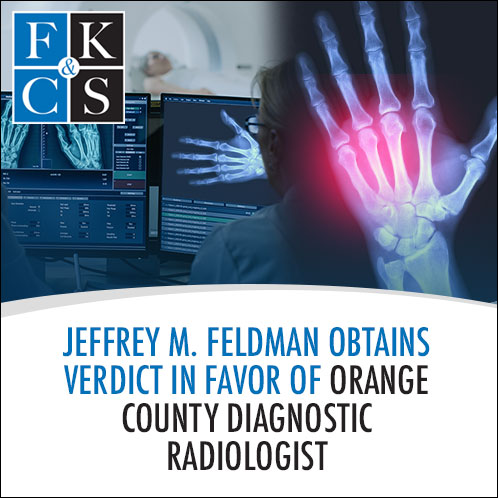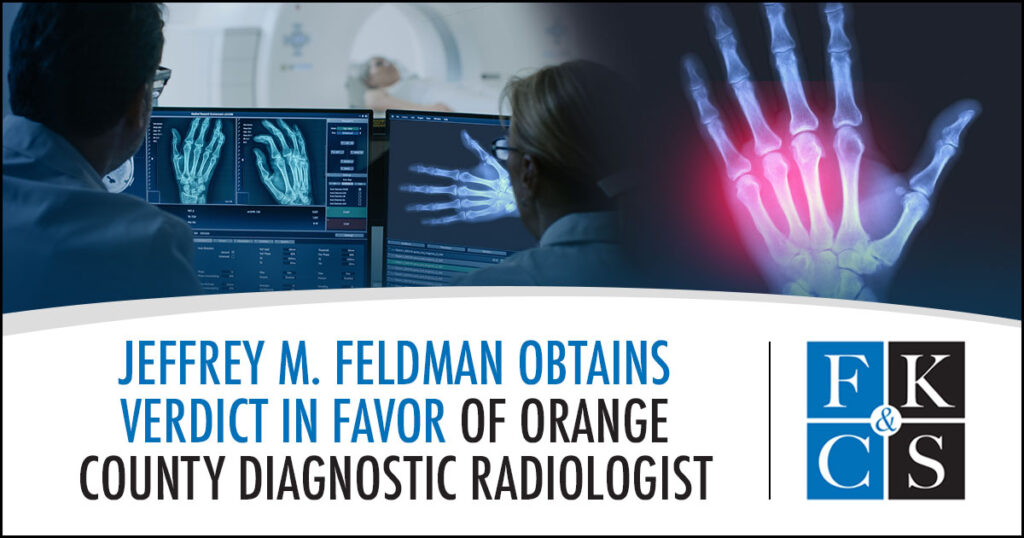 Jeffrey M. Feldman successfully defended an Orange County Diagnostic Radiologist in a case involving claimed failure to diagnose abnormalities on an MRI in April 2017.
Jeffrey M. Feldman successfully defended an Orange County Diagnostic Radiologist in a case involving claimed failure to diagnose abnormalities on an MRI in April 2017.
The plaintiff consulted with an orthopedic hand surgeon regarding pain in his non-dominant wrist, as well as two lumps – one on the dorsal or top of the wrist and the other on the ulnar (pinky side) side of the wrist. The dorsal lump had been present for four months and the ulnar lump for two months. The hand surgeon ordered an MRI without contrast, which was interpreted by Feldman, Kleidman, Collins & Sappe LLP’s (FKC&S) Orange County Diagnostic Radiologist client as reflecting tenosynovitis (inflammation of the flexor tendons) and a hemangioma (abnormal benign collection of blood vessels).
Based upon the clinical appearance and MRI results, the hand surgeon injected the plaintiff’s wrist with steroids for the tenosynovitis. When the plaintiff returned in July 2017, he indicated that the injection relieved some of the pain, but that it returned shortly after the last injection. Another injection was given in a slightly different location, again for the tenosynovitis. He returned in September 2017, claiming the second injection provided no relief.
The orthopedic hand surgeon recommended surgery for the tenosynovitis and to remove the two lumps (dorsal and ulnar). The plaintiff did not schedule the surgery because he did not have his schedule with him. Several days later, he was contacted again to schedule the surgery, but indicated that he would have to call back. Based upon the MRI report and clinical lack of any change, the hand surgeon did not consider that the plaintiff had anything but tenosynovitis and a benign collection of blood vessels.
In October, November and December, the plaintiff’s primary care physician ordered an ultrasound of the wrist, MRI of the hand, MRI of the wrist and, ultimately, an MRI of the hand with contrast. A different radiologist interpreted each of these studies and concluded that he had a low flow vascular malformation (different terminology – also a benign collection of blood vessels).
Several months later the plaintiff consulted with a different hand surgeon, who performed a biopsy which revealed a very rare soft tissue sarcoma – Myxoid Inflammatory Fibroblastic Sarcoma. He ultimately underwent a trans-radial amputation (amputation of his non-dominant arm at the forearm).
The claim against FKC&S’s radiologist client was that he failed to properly interpret the April 2017 MRI, that the MRI reflected abnormal areas of invasion inconsistent with a hemangioma and that an MRI with contrast should have been recommended as well as a biopsy. It was claimed that, had this exceedingly rare cancer (at the time 200 cases in the world’s literature) been diagnosed at the time of the MRI, the plaintiff would have only had to have a portion of his hand (pinky and possibly ring finger) and that portion of his hand removed.
An avid guitar player since his teenage years, the plaintiff (71 years old at time of trial) performed as a hobby at clubs and had permanent neuropathic pain following the amputation of 10/10.
At the time of trial, under cross examination, Feldman discerned that the plaintiff’s expert radiologist, Jordan Haber MD, had been provided with a letter from the plaintiff’s counsel outlining his clinical course, as well as his ultimate diagnosis, before he was provided with the MRI to review. Thus, Dr. Haber did not conduct a blind review, though he seemingly categorized it as such to the jury.
Haber testified that at the time of the MRI in April of 2017, the cancer was present on the ulnar, dorsal, palmar and radial (thumb) side. In other words, Haber opined that the cancer enveloped the entire hand of the plaintiff. This testimony was inconsistent with the surgical oncology expert’s testimony, which was that, had the cancer been diagnosed in April 2017, the pinky and possibly the ring finger would require removal. It was also inconsistent with the ultimate pathology report from Massachusetts General Hospital, where the transradial amputation was performed. Lastly, Haber failed to note or mention the December 2017 MRI, interpreted by another radiologist, which also concluded that this was a benign collection of abnormal blood vessels.
FKC&S’s radiology expert performed a blind review (he only had the MRI and the clinical history provided to our client) and his conclusion was the same as FKC&S’s client. He was then provided with FKC&S’s client’s report and agreed that his interpretation was correct. Upon being advised of the plaintiff’s ultimate diagnosis and amputation, the radiology expert looked back at the MRI and again indicated that no radiologist would see anything but a vascular malformation. The plaintiff was unfortunate to have a rare cancer that happened to mimic a benign collection of blood vessels in its radiographic appearance.
During summations, the plaintiff’s counsel requested $16 million for past and future damages. The jury returned a unanimous defense verdict in less than an hour finding that the MRI had been properly interpreted by the Orange County diagnostic radiologist.
Dr. Haber, the plaintiff’s expert radiologist, testified against another client of FKC&S in February and the jury returned a defense verdict in almost the same amount of time.
“As the trial attorney I’m in the courtroom and do a ton of the preparatory work, but these cases are a team effort,” said Feldman.” Terry Horner did a substantial amount of legal research and prepared many memos of law regarding some novel legal issues. Renne Harbolic, who has been my right hand for many years, handled many of the paralegal tasks. Thanks to our seamless collaboration, we were able to obtain the best possible result for our client.”

